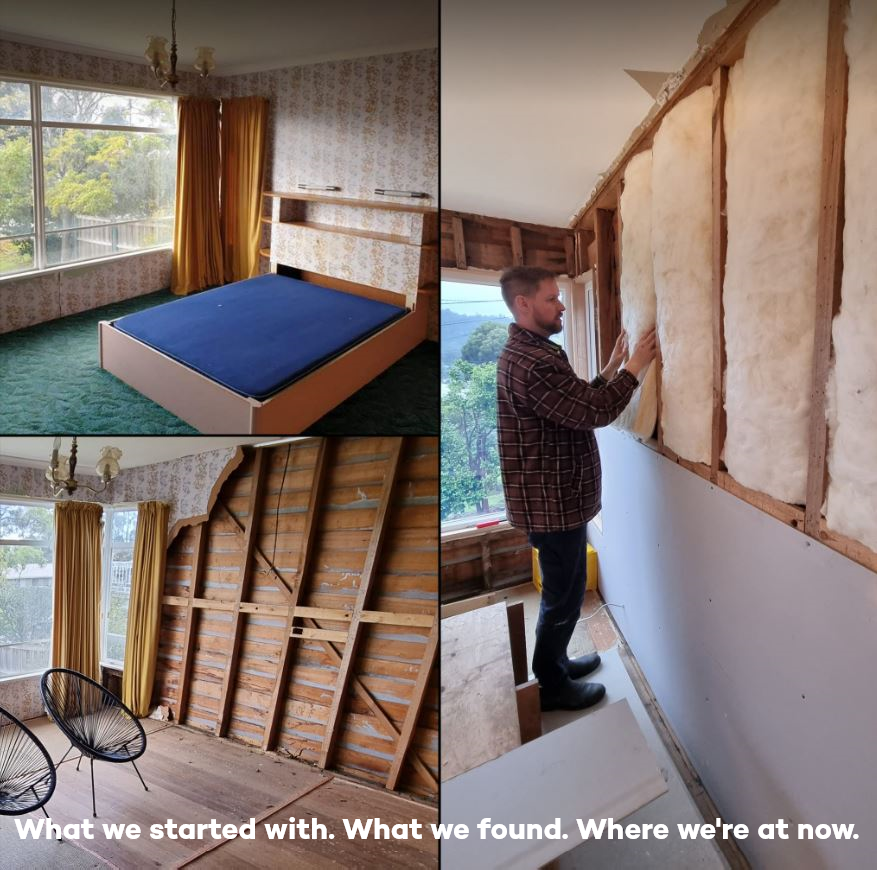Sign in to aurora+
Are you an existing aurora+ customer? Sign in here to check your balance, see your daily usage and top up.
Are you an existing aurora+ customer? Sign in here to check your balance, see your daily usage and top up.
Use our free online account management tools and forms to manage your account quickly and easily.
Aurora Energy team member, Cassie, found herself a little chilly in her new home. Find out how she and her husband insulated their fixer-upper below.
In July 2021, my husband and I bought a very run down, much neglected 1950’s weatherboard home in Kingston. To say it was a mess would be an understatement.
While it came with gorgeous original hardwood floors, sandstone fireplace, built in beds, and some very “stylish” turquoise carpet, some of its original features were not so glamorous – (did someone say bathroom carpet?)
When we started taking the 70 year old Masonite walls down to check the condition of the wiring we found there was absolutely zero insulation in the walls. All that was between us and the cold outside air were weatherboards.
Ours, like many older homes (and not so old homes, bulk wall insulation only became mandatory for newly built homes in 2005) had zero, zilch, nada from keeping the cold out and the warm in.
I’ve been at Aurora Energy for over 6 years, so it’s been drilled into me just how important home energy efficiency is to keep power costs low. Knowing that having a well-insulated home can save you up to 50% on heating and cooling costs, it was a no-brainer that insulation was going to the top of our list when we next went to the local hardware store (plus a cheeky sausage in bread while we're there).
So began our journey into the world of insulation.

Here’s what we learnt:
Bulk vs. reflective.
Bulk insulation is, as the name suggests, bulky. It looks like fluffy matting and can be made out of wool blends, polystyrene, and polyester. It allows you to trap heat inside your home when it's cold, and prevent it from getting in when it's hot outside.
Reflective insulation consists of a layer of foil backed by paper or plastic. It protects against radiant heat, bouncing the heat back. It's ideal in warmer climates to keep heat out.
Bulk insulation is better in colder climates to retain heat within the building.
Being in Southern Tasmania, our choice was obvious. It was the bulky stuff for us!
R-values express a material’s thermal resistance (how well it blocks heat). In Tassie, it’s recommended you choose a thermal rating of at least R2.5. The R value is pretty easy to find – it’s on the packet.
Ideally you’d want both. But that’s not always possible.
Unless you’re planning on doing major reno’s like us, walls can be pretty difficult and expensive to retrofit with insulation. You either have to remove your wall lining to install batts, or get a professional to install spray foam or blow-in cellulose insulation through small holes in your wall lining. This is usually more expensive as you can’t do yourself and will have to pay for a professional.
Ceiling insulation is the way to go if you have to choose. For one, you lose more heat out of your ceiling compared to your walls (hot air rises) and ceiling insulation can save you up to 35% on your heating costs.
Secondly, your ceiling cavity is usually a lot easier to access than your wall cavities, and it’s possible to DIY the install.
Wall and ceiling insulation is made out of the same stuff, wall batts are usually just thinner to fit into the cavity.
If your landlord isn’t keen on paying for insulation, all is not lost. Remember: the main point of insulating is to stop warm air escaping and cool air from getting in.
Block up gaps in windows and doors with weather seal tape.
Use rugs on hard floors.
Use door snakes to stop drafts.
Invest in lined curtains.
Keep rooms closed when you’re not using them.
Use caulk to seal cracks in floors.
Use bubble wrap on windows in rooms you don’t really use.
Plug up unused chimneys.